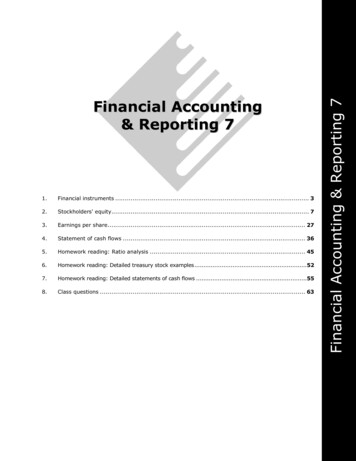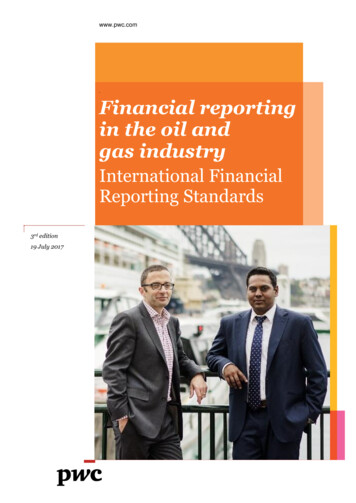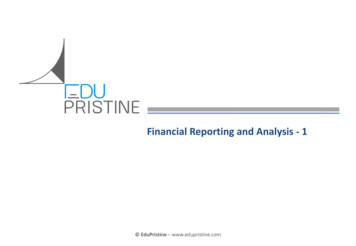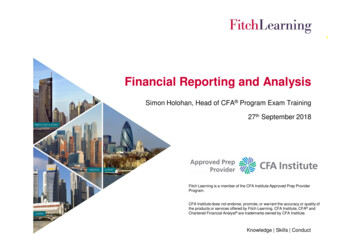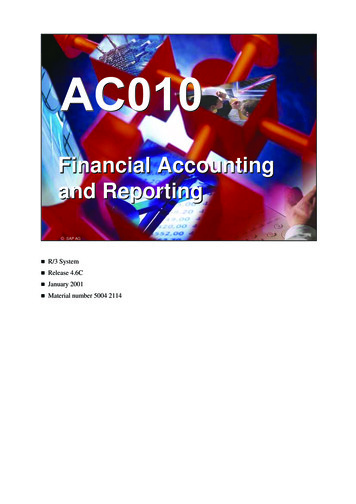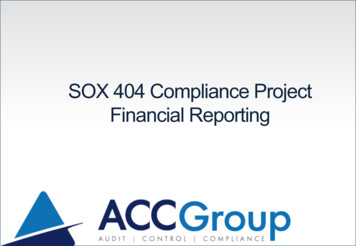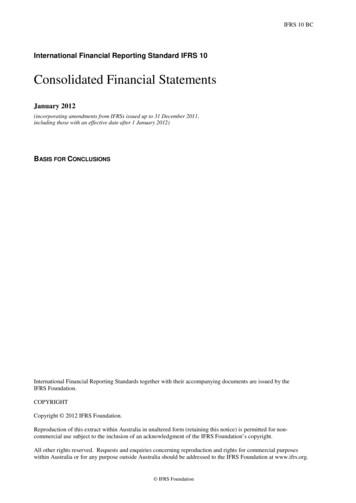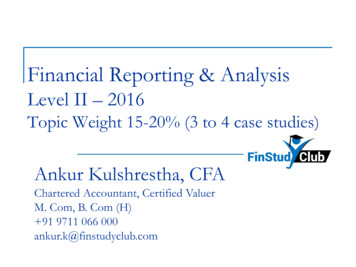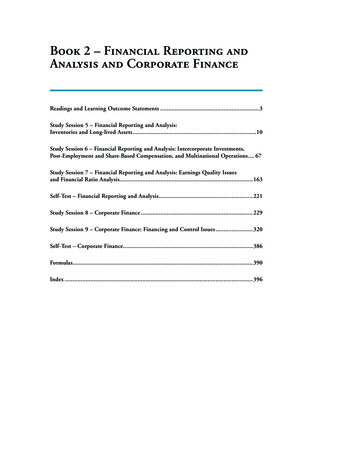
Transcription
Book 2 – Financial Reporting andAnalysis and Corporate FinanceReadings and Learning Outcome Statements.3Study Session 5 – Financial Reporting and Analysis:Inventories and Long-lived Assets.10Study Session 6 – Financial Reporting and Analysis: Intercorporate Investments,Post-Employment and Share-Based Compensation, and Multinational Operations. 67Study Session 7 – Financial Reporting and Analysis: Earnings Quality Issuesand Financial Ratio Analysis.163Self-Test – Financial Reporting and Analysis.221Study Session 8 – Corporate Finance.229Study Session 9 – Corporate Finance: Financing and Control Issues.320Self-Test – Corporate Finance.386Formulas.390Index.396Level 2 Book 2.indb 18/30/2010 4:37:37 PM
SchweserNotes 2011 CFA Level 2 Book 2: FINANCIAL REPORTING ANDANALYSIS and Corporate Finance 2010 Kaplan, Inc. All rights reserved.Published in 2010 by Kaplan Schweser.Printed in the United States of America.ISBN: 978-1-4277-2735-0 / 1-4277-2735-XPPN: 3200-0069If this book does not have the hologram with the Kaplan Schweser logo on the back cover, it wasdistributed without permission of Kaplan Schweser, a Division of Kaplan, Inc., and is in direct violationof global copyright laws. Your assistance in pursuing potential violators of this law is greatly appreciated.Required CFA Institute disclaimer: “CFA and Chartered Financial Analyst are trademarks ownedby CFA Institute. CFA Institute (formerly the Association for Investment Management and Research)does not endorse, promote, review, or warrant the accuracy of the products or services offered by KaplanSchweser.”Certain materials contained within this text are the copyrighted property of CFA Institute. The followingis the copyright disclosure for these materials: “Copyright, 2011, CFA Institute. Reproduced andrepublished from 2011 Learning Outcome Statements, Level 1, 2, and 3 questions from CFA ProgramMaterials, CFA Institute Standards of Professional Conduct, and CFA Institute’s Global InvestmentPerformance Standards with permission from CFA Institute. All Rights Reserved.”These materials may not be copied without written permission from the author. The unauthorizedduplication of these notes is a violation of global copyright laws and the CFA Institute Code of Ethics.Your assistance in pursuing potential violators of this law is greatly appreciated.Disclaimer: The Schweser Notes should be used in conjunction with the original readings as set forth byCFA Institute in their 2011 CFA Level 2 Study Guide. The information contained in these Notes coverstopics contained in the readings referenced by CFA Institute and is believed to be accurate. However,their accuracy cannot be guaranteed nor is any warranty conveyed as to your ultimate exam success. Theauthors of the referenced readings have not endorsed or sponsored these Notes.Level 2 Book 2.indb 28/30/2010 4:37:37 PM
Readings andLearning Outcome StatementsReadingsThe following material is a review of the Financial Reporting and Analysis, and CorporateFinance principles designed to address the learning outcome statements set forth by CFAInstitute.Study Session 5Reading AssignmentsFinancial Reporting and Analysis, CFA Program Curriculum, Volume 2, Level 2(CFA Institute, 2011)21. Inventories: Implications for Financial Statements and Ratios22. Long-lived Assets: Implications for Financial Statements and Ratiospage 10page 34Study Session 6Reading AssignmentsFinancial Reporting and Analysis, CFA Program Curriculum, Volume 2, Level 2(CFA Institute, 2011)23. Intercorporate Investments24. Employee Compensation: Post-Employment and Share-Based25. Multinational Operationspage 67page 101page 128Study Session 7Reading AssignmentsFinancial Reporting and Analysis, CFA Program Curriculum, Volume 2, Level 2(CFA Institute, 2011)26. The Lessons We Learn27. Evaluating Financial Reporting Quality28. Integration of Financial Statement Analysis Techniquespage 163page 172page 200Study Session 8Reading AssignmentsCorporate Finance, CFA Program Curriculum, Volume 3, Level 2(CFA Institute, 2011)29. Capital Budgeting30. Capital Structure31. Dividends and Share Repurchases: Analysis 2010 Kaplan, Inc.Level 2 Book 2.indb 3page 229page 275page 294Page 38/30/2010 4:37:37 PM
Book 2 – Financial Reporting and Analysis and Corporate FinanceReadings and Learning Outcome StatementsStudy Session 9Reading AssignmentsCorporate Finance, CFA Program Curriculum, Volume 3, Level 2(CFA Institute, 2011)32. Corporate Governance33. Mergers and Acquisitionspage 320page 336Learning Outcome Statements (LOS)The CFA Institute Learning Outcome Statements are listed below. These are repeated in eachtopic review; however, the order may have been changed in order to get a better fit with theflow of the review.Study Session 5The topical coverage corresponds with the following CFA Institute assigned reading:21. Inventories: Implications for Financial Statements and RatiosThe candidate should be able to:a. explain and calculate the effect of inflation and deflation of inventory costs onthe financial statements and ratios of companies that use different inventoryvaluation methods (cost formulas or cost flow assumptions). (page 10)b. discuss LIFO reserve and LIFO liquidation and their effects on financialstatements and ratios. (page 15)c. demonstrate how to adjust a company’s reported financial statements from LIFOto FIFO for purposes of comparison. (page 22)d. discuss the implications of valuing inventory at net realisable value for financialstatements and ratios. (page 23)e. analyze and compare the financial statements and ratios of companies, includingthose that use different inventory valuation methods. (page 25)f. discuss issues that analysts should consider when examining a company’sinventory disclosures and other sources of information. (page 27)The topical coverage corresponds with the following CFA Institute assigned reading:22. Long-lived Assets: Implications for Financial Statements and RatiosThe candidate should be able to:a. discuss the implications for financial statements and ratios of capitalising versusexpensing costs in the period in which they are incurred. (page 34)b. discuss the implications for financial statements and ratios of the differentdepreciation methods for property, plant, and equipment. (page 41)c. discuss the implications for financial statements and ratios of impairment andrevaluation of property, plant, and equipment, and intangible assets. (page 46)d. analyze and interpret the financial statement disclosures regarding long-livedassets. (page 49)e. discuss the implications for financial statements and ratios of leasing assetsinstead of purchasing assets. (page 50)f. discuss the implications for financial statements and ratios of finance leases andoperating leases from the perspective of both the lessor and the lessee. (page 51)Page 4Level 2 Book 2.indb 4 2010 Kaplan, Inc.8/30/2010 4:37:37 PM
Book 2 – Financial Reporting and Analysis and Corporate FinanceReadings and Learning Outcome StatementsStudy Session 6The topical coverage corresponds with the following CFA Institute assigned reading:23. Intercorporate InvestmentsThe candidate should be able to:a. describe the classification, measurement, and disclosure under the InternationalFinancial Reporting Standards (IFRS) for 1) investments in financial assets,2) investments in associates, 3) joint ventures, 4) business combinations, and5) special purpose and variable interest entities (SPEs, VIEs). (page 67)b. distinguish between IFRS and U.S. GAAP in the classification, measurement,and disclosure of investments in financial assets, investments in associates,joint ventures, business combinations, and special purpose and variable interestentities. (page 67)c. analyze the effects on financial ratios of the different methods used to accountfor intercorporate investments. (page 87)The topical coverage corresponds with the following CFA Institute assigned reading:24. Employee Compensation: Post-Employment and Share-BasedThe candidate should be able to:a. discuss the types of post-employment benefit plans and the implications forfinancial reports. (page 101)b. explain the measures of a defined benefit pension plan’s liability (i.e., definedbenefit obligation and projected benefit obligation). (page 102)c. describe the components of a company’s defined benefit pension expense.(page 106)d. explain the impact of a defined benefit plan’s assumptions on the defined benefitobligation and periodic expense. (page 108)e. explain the impact on financial statements of International Financial ReportingStandards (IFRS) and U.S. Generally Accepted Accounting Principles (U.S.GAAP) for pension and other post-employment benefits that permit items to bereported in the footnotes rather than in the financial statements. (page 110)f. evaluate pension plan footnote disclosures including cash flow relatedinformation. (page 116)g. evaluate the underlying economic liability (or asset) of a company’s pension andother post-employment benefits. (page 116)h. calculate the underlying economic pension expense (income) and otherpostemployment expense (income) based on disclosures. (page 113)i. discuss the issues involved in accounting for share-based compensation.(page 117)j. explain the impact on financial statements of accounting for stock grants andstock options, and the importance of companies’ assumptions in valuing thesegrants and options. (page 117)The topical coverage corresponds with the following CFA Institute assigned reading:25. Multinational OperationsThe candidate should be able to:a. distinguish among presentation currency, functional currency, and localcurrency. (page 128)b. analyze the impact of changes in exchange rates on the translated sales of thesubsidiary and parent company. (page 128) 2010 Kaplan, Inc.Level 2 Book 2.indb 5Page 58/30/2010 4:37:37 PM
Book 2 – Financial Reporting and Analysis and Corporate FinanceReadings and Learning Outcome Statementsc. compare and contrast the current rate method and the temporal method,analyze and evaluate the effects of each on the parent company’s balance sheetand income statement, and determine which method is appropriate in variousscenarios. (page 130)d. calculate the translation effects, evaluate the translation of a subsidiary’s balancesheet and income statement into the parent company’s currency, and analyzethe different effects of the current rate method and the temporal method on thesubsidiary’s financial ratios. (page 136)e. analyze how using the temporal method versus the current rate method willaffect the parent company’s financial ratios. (page 144)f. illustrate and analyze alternative accounting methods for subsidiaries operatingin hyperinflationary economies. (page 148)Study Session 7The topical coverage corresponds with the following CFA Institute assigned reading:26. The Lessons We LearnThe candidate should be able to:a. distinguish among the various definitions of earnings (e.g., EBITDA, operatingearnings, net income, etc.). (page 164)b. illustrate how trends in cash flow from operations can be more reliable thantrends in earnings. (page 165)c. provide a simplified description of the accounting treatment for derivativesbeing used to hedge: exposure to changes in the value of assets and liabilities, exposure to variable cash flow, and a foreign currency exposure of an instrument in a foreign corporation.(page 165)The topical coverage corresponds with the following CFA Institute assigned reading:27. Evaluating Financial Reporting QualityThe candidate should be able to:a. contrast cash-basis and accrual-basis accounting and explain why accountingdiscretion exists in an accrual accounting system. (page 172)b. describe the relation between the level of accruals and the persistence of earningsand the relative multiples that the cash and accrual components of earningsshould rationally receive in valuation. (page 174)c. discuss the opportunities and motivations for management to intervene in theexternal financial reporting process and the mechanisms that discipline suchintervention. (page 175)d. discuss earnings quality and the measures of earnings quality, and compare andcontrast the earnings quality of peer companies. (page 177)e. explain mean reversion in earnings and how the accruals component of earningsaffects the speed of mean reversion. (page 181)f. discuss problems with the quality of financial reporting, including revenuerecognition, expense recognition, balance sheet issues, and cash flow statementissues, and interpret warning signs of these potential problems. (page 182)Page 6Level 2 Book 2.indb 6 2010 Kaplan, Inc.8/30/2010 4:37:37 PM
Book 2 – Financial Reporting and Analysis and Corporate FinanceReadings and Learning Outcome StatementsThe topical coverage corresponds with the following CFA Institute assigned reading:28. Integration of Financial Statement Analysis TechniquesThe candidate should be able to:a. demonstrate the use of a framework for the analysis of financial statements,given a particular problem, question, or purpose (e.g., valuing equity based oncomparables, critiquing a credit rating, obtaining a comprehensive picture offinancial leverage, evaluating the perspectives given in management’s discussionof financial results). (page 200)b. identify financial reporti
The following material is a review of the Financial Reporting and Analysis, and Corporate Finance principles designed to address the learning outcome statements set forth by CFA Institute. Study SeSS ion 5 Reading Assignments Financial Reporting and Analysis, cFA Program curriculum, volume 2, Level 2 (cFA Institute, 2011) 21. Inventories: Implications for Financial Statements and ratios page 10



